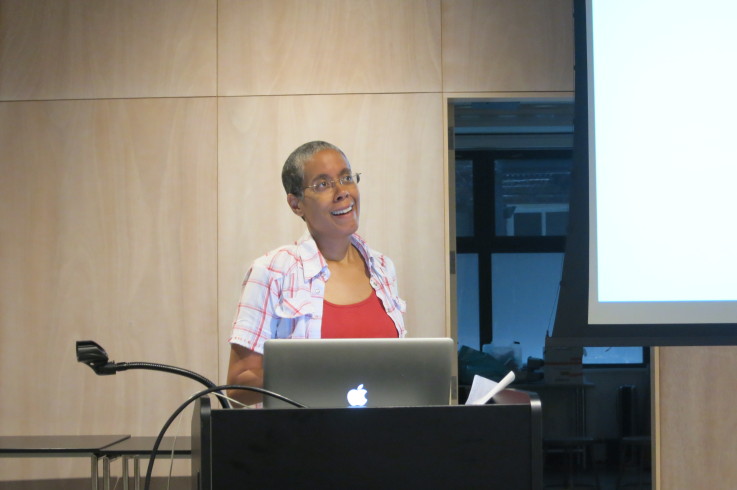On an afternoon in July, more than thirty ART21 Educators gathered at the Joan Mitchell Foundation to hear artist Laylah Ali’s talk on process. Constantly accruing a collection of snapshots, diaries, journals, and sketchbooks is always a part of her art-making method she said, but when the Dia Art Foundation commissioned her to create a web-based project, the painter found herself in uncharted territory.
Inspired by childhood memories of her grandmother singing “John Brown’s Body,” a marching song about the abolitionist John Brown, Ali set out to create a flexible collection of videos and resources documenting the complex history of the song and its subject. The lyrics of the original song referenced the harsh truths of the black experience, including hangings and repeated references to Brown’s body “a-mouldering in the grave.” The history of the lyrics themselves is a complicated one, with varying versions that are often wholly different, as was most famously the case with Julia Ward Howe’s “Battle Hymn of the Republic.”
Ali’s project take the history of the song as its starting point, later continuing the investigation into the memory and documentation of the abolitionist who inspired it. Originally the idea was to film a professional singing the song’s original version, but this transitioned into a more personal, broad-based selection of singers. Ali asked family and friends to sing their version of the song without accompaniment, and intentionally selected people she had a relationship with who weren’t “professionally musical,” but nevertheless possessed “performative instincts.” The end result is nineteen paired videos of individuals singing alone to the cameras on their computers (the one video that isn’t paired was done by an opera singer, and thus outside the “non-professional” scope). “If you have the patience to stay with the project, it becomes this cumulative narrative that deepens,” Ali said, “The more you stay with it the more it gives back.”
Actor Jesse L. Martin sings “John Brown’s Body” in Laylah Ali’s John Brown Song!
Inspired by Youtube, the project’s central component is its flexibility, in which viewers control their experience of the content offered up by the artist. The site’s final element is a collection of endnotes—a compilation of Ali’s research on John Brown and the history of “John Brown’s Body.” In these, the artist worked to correct history, showing a clip from a largely incorrect 1940 film about John Brown, while bringing in little-known facts that make the true events feel even more real, like the peanut shells that would have been crunching on the ground during Brown’s trial.
Ali said she was “just trying to put different textures on this site,” carefully compiling new and historical information on who John Brown was and how he and the song have been remembered. Chance plays an important role, but she said her process for the project involved “keeping a lot of things in play and then paring down.” Another big aspect involved designing the project around the medium—being fully aware that anyone can find whatever they’d like to know about John Brown online, and offering a new perspective. “I liked how this breathed a bit more than my paintings,” Ali said of the project.
The artist concluded by sharing her notes on the process of creating art—traditional, digital or otherwise:
- Use structure as “a guiding tool into the ambiguity.”
- “You have to make a prompt that gives them something to hold onto.”
- When teaching about an artwork in the classroom (as Ali is a teacher herself), build into the planning process preemptive thoughts like “What’s the danger with this one?” Consider all the possible ways an artwork, prompt, or assignment could be misunderstood.
- And above all, the most useful skill in art practice is discipline—dedicating yourself to projects in ways that are both structured and practical. There’s a relief that comes in “knowing that kind of discipline can bring you back from even the most catastrophic errors,” the artist said, like ruining a work-in-progress with spilt tea.
Experience Laylah Ali’s John Brown Song! online, and learn more about ART21 Educators at art21.org/learn.




